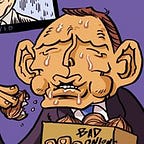The Leadership Rhombus™: How to Kill Visual Metaphor
I’m very pleased to reveal to you the story of the incredible Leadership Rhombus™, a powerful visual framework. It will bring your organisation untold benefits!
Let me get to that by first telling you about a fantastic conference I went to.
VizConf 2018
This month the first VizConf, an Australian conference for visual practitioners, was held at the offices of MYOB in Melbourne.
What’s a visual practitioner? We’re talking professional visual scribes, but also plenty of ordinary people who like creating and using visual tools in their day jobs, including people from the world of human-centred design/service design/UX/Agile.
The day was organised as an Open Space event, or “unconference”. If you haven’t been to one of these — it means the event is self-organising, with an agenda created on the day according to the conversations the attendees want to have.
Let’s Kill Visual Metaphor
At the start of the day I suggested a session called “Let’s Kill Visual Metaphor”.
Luckily for me, designer and design educator Ben Crothers was in attendance (we’d never met), and wanted his own discussion about how great visual metaphor is! Between us we decided we’d combine our talks into one knock-down, drag-out fight.
Ben spoke eloquently about visual metaphor. Metaphor fills a gap between the literal and the conceptual. Being able to share a common visual metaphor brings us closer to that beautiful state known as, “Everybody gets it”. As Ben said: “Let’s draw the problems so we understand them.”
A metaphor well used can grab people’s hearts as well as minds. It can make empathy happen.
I agree with all this! But guess what? We tend to default to metaphors that are either BORING (obvious) or TORTURED (poorly conceived). Result: they don’t have impact.
A bigger problem is that organisations may use them in a way that obscures truth, or isn’t representative of what they’re actually saying. Then they’re not only failing to communicate, they’re dangerous.
“Draw me a mountain”
Senior leaders love showing their people graphics of mountains.
The mountain will be climbed by the team, and at the peak is a shiny, happy goal of some kind. What if the team sees the mountain differently?
The tension between these two mountains — the disconnect in the way leaders and teams are looking at their situation — is much more interesting and useful to depict!
You often don’t have to invent these metaphors; they come naturally out of conversation. People come up with their own metaphors to help them describe the situations they’re dealing with.
This is not about killing visual metaphor — this is about killing lazy, ineffective communication.
Imagine the difference between these two situations:
1. A team leader shows her team a happy mountain. She talks about the “roadmap to 2020”. Everyone dutifully claps like they’re supposed to.
2. A team leader fosters discussion with her team, which leads to a new visual metaphor — one specific to their situation. They use this image to have frank conversation about what threatens the project and how the problems can be addressed.
Which team “communicated” and which got “comms”?
The Leadership Rhombus™
A client once approached me looking for an illustration. Her business unit, she said, wanted to depict visually their New Way of Working. She had found something on Google Images she felt symbolised it. It looked like this:
I thought it was boring, and unworthy of an exciting new venture. Instead I presented her with the Leadership Rhombus™:
You’re welcome.
Killing it with visual metaphor
- Know your audience.
- Bin cliché and find the metaphor that resonates with them.
- Explore and evolve the idea with that audience to find deeper truths.
- Just skip visual metaphor altogether and tell real stories instead.
David Blumenstein is a service designer and cartoonist. He’s finishing out the year with Drawing for Story workshops in Melbourne (Nov 3 and Dec 9) and Sydney (Dec 8). Visualising your communication challenge in a few hours! Come do it.
Ben Crothers' recap of VizConf 2018 is here.
Thanks to Xavier Ho and Justin Cheong, without whose twitterstreaming I wouldn’t remember what the heck we said!
If your company would like an expensive license to use the Leadership Rhombus™ framework, contact me directly.
